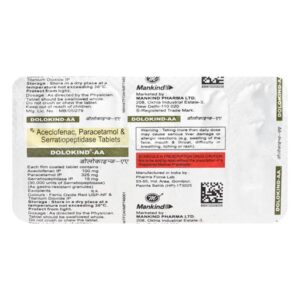ACECLOFENAC + PARACETAMOL + SERRATIOPEPTIDASE
Aceclofenac: Aceclofenac is a nonsteroidal anti-inflammatory drug (NSAID) used for the treatment of pain and inflammation in conditions such as osteoarthritis, rheumatoid arthritis, and ankylosing spondylitis.
Its mechanism of action involves inhibiting the enzyme cyclooxygenase (COX), which is responsible for the production of certain chemicals called prostaglandins. By inhibiting COX, aceclofenac reduces the synthesis of prostaglandins, thereby decreasing pain, inflammation, and swelling.
The usual recommended dose of aceclofenac is 100mg to 200mg per day, taken orally in divided doses. It is commonly taken with food to reduce the risk of stomach upset.
As with any medication, aceclofenac may cause some side effects. Common side effects include gastrointestinal disturbances such as abdominal pain, indigestion, nausea, vomiting, and diarrhea. Other possible side effects may include headache, dizziness, skin rash, itching, and fluid retention. In rare cases, the use of aceclofenac has been associated with severe skin reactions, liver problems, and allergic reactions. It is important to seek medical attention if any unusual or severe side effects occur.
Aceclofenac is contraindicated in individuals with a history of hypersensitivity to NSAIDs, gastric ulcers or bleeding, severe heart failure, severe liver or kidney disease, or those who are in the third trimester of pregnancy. It should be used with caution in individuals with a history of gastrointestinal disorders, hypertension, and asthma.
It is important to consult a healthcare professional before taking aceclofenac to ensure it is safe and appropriate for use, especially if you have any pre-existing medical conditions or are taking other medications.
Paracetamol: Paracetamol, also known as acetaminophen, is a widely used over-the-counter analgesic and antipyretic medication. It is commonly prescribed for the relief of pain and to reduce fever.
The exact mechanism of action of paracetamol is still not fully understood, but it is thought to work by inhibiting the production of certain chemicals in the brain that transmit pain signals and regulate body temperature. Unlike other non-steroidal anti-inflammatory drugs (NSAIDs), paracetamol has little to no anti-inflammatory effects.
The recommended dose of paracetamol for adults is generally 500 to 1000 mg every four to six hours, with a maximum daily dose of 4 grams (4000 mg). However, the specific dosage may vary depending on the individual’s age, weight, and underlying health conditions. It is important to carefully follow the dosing instructions provided by a healthcare professional or the product label to avoid overdosing.
While paracetamol is generally considered safe when used as directed, it is not without potential side effects. The most common side effects include nausea, vomiting, loss of appetite, and abdominal pain. In rare cases, it may cause severe skin reactions, such as Stevens-Johnson syndrome or toxic epidermal necrolysis. Overdosing on paracetamol can lead to liver damage and even liver failure, which can be fatal. It is crucial to avoid exceeding the maximum daily dose and to seek immediate medical attention in case of an overdose or severe side effects.
It is important to note that paracetamol should not be used in certain situations, such as in individuals with liver disease, as it can worsen the condition. It is always recommended to consult with a healthcare professional or pharmacist before starting any new medication to ensure it is safe and appropriate for use.
Serratiopeptidase: Serratiopeptidase is an enzyme derived from bacteria called Serratia. It is commonly used as a medication to reduce pain, inflammation, and congestion. It belongs to a class of drugs known as proteolytic enzymes.
The mechanism of action of Serratiopeptidase involves its ability to break down proteins and peptides in the body, which helps to reduce inflammation by preventing the accumulation of fibrin and other inflammatory mediators. Additionally, it can help in removing dead tissue and increasing the circulation of blood to the affected area.
The recommended dosage of Serratiopeptidase can vary depending on the condition being treated. Generally, it is advised to take 10-30 mg of Serratiopeptidase orally, 1-3 times a day, with or without food. The duration of treatment may vary as directed by a healthcare professional.
Like any medication, Serratiopeptidase can have certain side effects. Common side effects may include gastrointestinal symptoms such as nausea, vomiting, diarrhea, or stomach upset. Rarely, allergic reactions such as rash, itching, or swelling may occur. If any severe side effects such as severe stomach pain, black stools, or difficulty breathing are experienced, immediate medical attention should be sought.
It is important to note that Serratiopeptidase should not be used without proper medical supervision. It is advisable to consult a healthcare professional before starting this medication, especially if you have any underlying medical conditions or are taking other medications, as it may interact with certain drugs.

